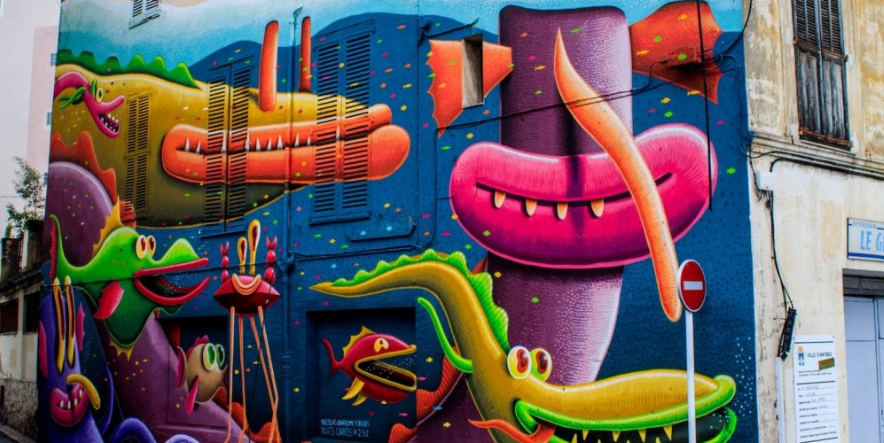How to make a mural. On the entrance wall, amaze all your guests as soon as they cross the threshold. In your place, to feel it really yours. Or outside, to show everyone your art. Making a mural, as long as you have the suitable materials, the right passion, and an excellent creative idea is not difficult. Indeed, it can be simple and, overall, so fun. In this guide, we will explain how to make a mural outside or inside, using acrylic colors for street art and wall paintings to give your work shine and resistance over time. Are you ready to learn everything you need to know to paint on the walls?
The history of the mural, in a nutshell
Man has always drawn on the banks: he did it in holes, representing sporting scenes for propitiatory ideas, and he proceeded to do so again the following times and happiness, decorating palaces and churches. In the broadest sense, the term murals indicate any painting carried out on a wall without indicating an exact historical period. Nonetheless, it should be emphasized that, in its most modern meaning, ‘murals mainly refers to large-scale paintings with political and ideological connotations, and for this reason often executed outside, for the benefit of the entire citizenry.
The flashback of the mural picture, after a few times of indifference, had no social meaning. In the 19th century, the artists returned to decorate the walls for purely aesthetic purposes, as the murals of the Montecatini thermal baths remind us. It was shortly after in revolutionary Mexico – when the population opposed the dictatorship of General Porfirio Diaz, between 1910 and 1920 – that the ideological ‘mural’ was born, done in the public square or along the streets to communicate precise messages to the masses: the social value of art, in those years, was definitively rediscovered, while combining realistic style murals with visionary or expressionist paintings. Starting from the Mexican experience, the mural intended as a powerful expression and communication expand worldwide in the most diverse styles.
You are making a mural: how to get started?

To create a mural, one does not immediately start with acrylic colors for street art. First, it is, in fact, necessary to prepare the wall to receive the painting. The first step is to thoroughly clean the wall on which you are going to paint: whether it is an external or internal wall, it must be free from dust, encrustations, or other stains that could compromise the perfect success of the work. To carry out this cleaning operation, you usually start with an overall brushing of the wall, pass it all over with a sponge dipped in water and detergent, rinse everything, and let it dry.
In case you want to extend the subsequent duration of the mural to the maximum (which, in any case, with acrylic colors for wall painting, will already be very long in itself), you can do even more by scratching the wall paint with some sandpaper, and then proceed with cleaning. Once the wall has been cleaned and allowed to dry, it is necessary to apply a primer, which, in addition to making the substrate uniform, will serve to give more strength to the work, enhancing the grip of the colors. On our e-commerce, you can find different primers, from white chalk to modeling paste, up to black chalk.
When the primer is also dry, your wall will be ready to be decorated finally. However, it is not sure that you can start immediately with brushes and acrylic paints. In fact, in most cases, you will need to make a preparatory sketch, starting with a smaller sketch made on paper. The options, in this case, are two: you can adopt the grid technique to reproduce patiently, square by square, your design on the wall. Otherwise, you can speed up everything using a projector to ‘print’ your preparatory landscape drawing on your wall, following all the signs with your pencil.
Paint a mural with acrylic paints
Why on earth do we assume that you have to use acrylic paints? This type of paint is used for wall painting which, while reminiscent of tempera, gives a brighter and brighter result and lasts much longer over time. But that’s not all! It should highlight that acrylic colors for street art are also very resistant to atmospheric agents, not yellowing like other dyes. This aspect is fundamental as the murals will often be outdoors and will have to withstand rain, humidity, and cold. Read our guide dedicated to the best acrylic paints to paint if you want to know more and better understand the world of acrylic colors.
Explained why, for wall painting, acrylic paints are preferred. You can start making a mural. If you paint indoors, make sure children, dogs, cats, and bunnies do not enter the room while you are at work or while the paint is drying: their slaps or paws, while funny, could cause significant damage to your work! In addition to acrylic colors for street art, you will need brushes of different sizes and shapes to spread large areas of color and paint the minor details. Moreover, those who are used to painting on their easel will not have significant difficulties in moving to the wall: the painting technique required is practically the same.
We start first by applying the color in the most expansive fields to create the background. You will return later to paint the details. It must say that, in addition to brushes, you can also use other accessories, such as sponges, perfect for creating intriguing textures on the wall, especially when there is a need to paint clouds, trees, or bushes. Another technique widely used in murals with acrylic colors is pointillism, stippling with a brush, which allows us to create spectacular effects: the realism that can be achieved in painting green fields of grass with this technique is impressive.
Also Read: Color brushes